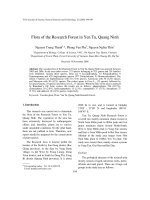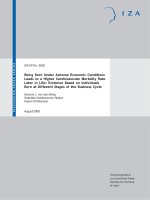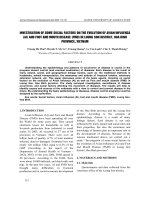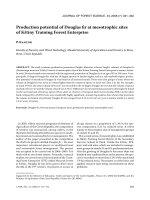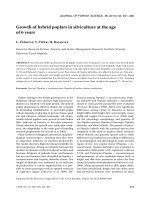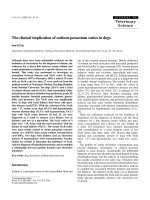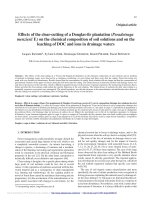Soil infiltration characteristics at different age of acacia plantation forest in luong son headwater hoa binh vietnam
Bạn đang xem bản rút gọn của tài liệu. Xem và tải ngay bản đầy đủ của tài liệu tại đây (1 MB, 49 trang )
MINISTRY OF AGRICULTURE AND RURAL DEVELOPMENT
VIETNAM NATIONAL UNIVERSITY OF FORESTRY
STUDENT THESIS
SOIL INFILTRATION CHARACTERISTICS AT DIFFERENT AGE OF ACACIA
PLANTATION FOREST IN LUONG SON HEADWATER, HOA BINH, VIETNAM
Major: Advanced Curriculum in Natural Resources Management
Code: D850101
Faculty: Forest Resources & Environmental Management
Student: Tran Ngoc Lan
Student ID: 1453090551
Class: K59A - Natural Resources Management
Course: 2014 – 2018
Advanced Education Program
Developed in Collaboration with Colorado State University, USA
Supervisor:
Assoc.Prof. Bui Xuan Dung
Ha Noi, 2018
ACKNOWLEDGEMENT
First and foremost, I would like to express our sincere respect to our supervisor Assoc. Prof. Dr. Bui Xuan Dung for his enthusiastic and patient support with invaluable
comments. In addition, I appreciated the support of other lectures during the time we analyzed
the data.
Not only that, many thanks are due to my friends when I started to collect and analyze
data. They always give me the support whenever I needed.
Lastly, I express my gratitude to local people who own the Acacia plantation model
for allowing me to conduct this research in this site.
Hanoi, August 2018
i
TABLE OF CONTEND
ACKNOWLEDGEMENT .......................................................................................................... i
TABLE OF CONTEND ............................................................................................................ ii
LIST OF TABLE ...................................................................................................................... iv
LIST OF FIGURE ..................................................................................................................... v
ABSTRACT .............................................................................................................................. 1
CHAPTER I............................................................................................................................... 2
INTRODUCTION ..................................................................................................................... 2
CHAPTER II ............................................................................................................................. 5
GOALS AND OBJECTIVES.................................................................................................... 5
2.1. Goal .................................................................................................................................... 5
2.2.
Objectives ....................................................................................................................... 5
CHAPTER III ............................................................................................................................ 6
STUDY SITE AND METHODS .............................................................................................. 6
3.1. Study site ............................................................................................................................ 6
3.2. Methods .............................................................................................................................. 8
3.2.1. Infiltration measurement ................................................................................................. 8
3.2.2. Soil properties ............................................................................................................... 10
CHAPTER IV. ......................................................................................................................... 13
RESULTS AND DISCUSSIONS ........................................................................................... 13
4.1. Soil infiltration characteristics at different ages of Acacia plantation.............................. 13
4.1.1. Infiltration rate at different ages of Acacia plantation forest ....................................... 13
4.1.2. Initial and stable infiltration rate .................................................................................. 19
4.1.3. Total water infiltrate in 1 hour ...................................................................................... 22
ii
4.2. Impact factors on Infiltration characteristics at different ages of Acacia plantation ........ 23
4.2.1. Soil physical and vegetation characteristics at different ages of Acacia plantation..... 23
4.2.2. Affecting factors on soil infiltration at different ages of Acacia plantation .................. 29
CHAPTER V ........................................................................................................................... 36
CONCLUSION, LIMITATIONS AND RECOMMENDATIONS ........................................ 36
5.1. Conclusion ........................................................................................................................ 36
5.2. Limitations ........................................................................................................................ 37
5.3. Recommendations ............................................................................................................ 37
REFERENCES .......................................................................................................................... 1
APENDIX.................................................................................................................................. 4
iii
LIST OF TABLE
TABLE 3.1. DATA OF INFILTRATION IN DIFFERENT AGES ACACIA FOREST ............ 9
TABLE 4.1. VEGETATION CHARACTERISTICS AT DIFFERENT AGES OF ACACIA
PLANTATION ......................................................................................................................... 23
TABLE 4.2. SOIL PROPERTIES AND INFILTRATION CHARACTERISTIC ................... 29
iv
LIST OF FIGURE
Figure 3.1. The map of study site: a) Location of Hoa Binh province on Viet Nam map; b)
Location of Luong Son district on Hoa Binh map; c) Location of Truong Son commune on
Luong Son map........................................................................................................................... 7
Figure 3.2. Contour map of study site ........................................................................................ 8
Figure 3.3. Infiltration measurement in Acacia plantation ......................................................... 9
Figure 3.4. Dry Bulk Density Tube .......................................................................................... 11
Figure 3.5.Soil analysis in laboratory by using oven ............................................................... 12
Figure 3.6. Determine slope, coordinate system and vegetation cover .................................... 12
Figure 3.7. Data analysis .......................................................................................................... 12
Figure 4.1. Infiltration rate of bare land ................................................................................... 13
Figure 4.2. Infiltration rate of 1-year-old Acacia plantation .................................................... 14
Figure 4.3. Infiltration rate of 3-years-old Acacia plantation ................................................... 15
Figure 4.4. Infiltration rate of 4-years-old Acacia plantation ................................................... 16
Figure 4.5. Average infiltration rate at different ages Acacia plantation ................................. 17
Figure 4.6. Infiltration rate in 2 type of soil (Horton, 1933) .................................................... 18
Figure 4.7. Initial infiltration rate of 4 different ages Acacia plantation .................................. 19
Figure 4.8. Stable Infiltration rate of 4 different ages Acacia plantation ................................. 20
Figure 4.9. Correlation between Stable rate and Initial rate ..................................................... 21
Figure 4.10. Total water infiltrate in 1 hour in 4 different ages of Acacia plantation .............. 22
Figure 4.11. Total water in 1 hour compared with other land uses (Source: Dung et al, 2016,
Soil infiltration characteristics of different land use at Luot mountain, Xuan Mai, Hanoi) ..... 22
Figure 4.12. Bulk density of 4 different ages Acacia plantation .............................................. 24
Figure 4.13. Porosity of 4 different ages Acacia plantation ..................................................... 25
v
Figure 4.14. Soil moisture of 4 different ages Acacia plantation ............................................. 27
Figure 4.15. Understory vegetation coverage of 4 different ages Acacia plantation ............... 28
Figure 4.16. Affecting factors on infiltration ........................................................................... 30
Figure 4.17. Correlation between initial rate and soil moisture ............................................... 31
Figure 4.18. Correlation between initial rate and understory vegetation coverage .................. 31
Figure 4.19. Correlation between a) Stable rate and porosity, b) Stable rate and dry bulk
density....................................................................................................................................... 32
Figure 4.20. Correlation between Stable rate and Understory vegetation cover. ..................... 33
Figure 4.21. Storm events from September 29th to October 24th, 2018 in study site (Source:
D.Hoa, P.Trang, V.Thu, T.Lan, N.Cong, 2018, Evaluating effects of Acacia Plantation forest
on overland flow and soil erosion in Luong Son headwater of Vietnam ................................. 34
vi
ABSTRACT
To determine the soil infiltration characteristics in different ages of acacia plantation
forest in Luong Son-Hoa Binh head water of Vietnam. I choose to do a field experiment for
infiltration measurement at different vegetation cover conditions (bare land, 1 years-old
Acacia trees, 3-year-old Acacia trees and 4-year-old Acacia trees) from July to August 2018. I
also determine a number of affecting factors such as soil physical and vegetation
characteristics of Acacia plantation in Truong Son Commune, Luong Son district, Hoa Binh
Province. The main findings include: (1) Infiltration rate in four different ages of Acacia
plantation tended to be decreased over time. Both initial and stable rate are increase from bare
land to 4 years old of Acacia Mangium forest. (2) Infiltration rate has a strong relationship
with soil physical and vegetation coverage of study site. Initial infiltration rate of soil has
strong negative relationship with soil moisture and but do not has significant relationship with
porosity and dry bulk density. Meanwhile, stable rate does not has relationship with soil
moisture but has strong relationship with porosity and dry bulk density. (3)The findings
implied that infiltration rate under Acacia plantation forest has been higher than bare land.
Maybe the root and understory have important impacts on infiltration characteristics of soil
Key words: Acacia plantation model, bare land, infiltration, headwater, porosity
vegetation cover conditions
1
CHAPTER I
INTRODUCTION
Infiltration is the process in which water entries downward into the immediate surface
of soil or other materials (Horton, 1933). It is one of the issues studied extensively in the field
of hydrology. From the theory of surface flow, infiltration is indicative of the ability of the
most important regulator stage in forest hydrology, after rainfall has passed through the
atmosphere, vegetation coverage and fallen cover (Sharma el al, 1980). Infiltration capacity of
soil is very important in forming the mechanism of surface flow, subsurface flow and soil
erosion. Thus in the area that has high infiltration rate, soil has high infiltration capacity, there
will be little or no overland flows (Horton, 1933). So surface erosion does not occur or occurs
with very low frequency. In contrast, soil has low infiltration rate leads to more overland
flows (Hai, 1993). So there may be occur erosion with higher frequency. Therefore, it is easy
to effectively manage land and water resources, infiltration rate plays an important role in
watershed management.
There are many factors affecting infiltration rate of soil, include precipitation, soil
texture and structure, terrain and vegetation and precipitation characteristics combine the
amount of rain, intensity and frequency of rainfall (Dien el al, 2016). In the case of heavy
rainfall and intensity of rainfall, the infiltration of the soil tends to be small. In case of
precipitation and intensity of rainy season, the infiltration capacity will be higher (Haws el al,
2016). Soil factors that control infiltration rate are vegetation cover, root development,
organic content (Dune et al, 1991). In general, soil with high vegetation cover has high
infiltration rate (Hiraoka, 2010). Furthermore, some factors such as soil moisture, bulk
density, porosity, soil texture and structure also have significant effects on infiltration rate. In
three factors that affect the infiltration of soil, we can manage two factors including soil
characteristics and vegetation. Therefore, management solutions are also focused on these two
2
factors. Studies on surface runoff and soil erosion by Lung and Hai (1997) show that the
thicker the forest, the more water is absorbed into the soil and converted into the underground
flow. , the greater the ability to reduce erosion. Research of Lung et al. (1995) show that
permeability is considered to be a major factor in erosion and flow. Other works also mention
the effect of vegetation type on the infiltration of forest land such as Pho (1992), Dung
(1993). The authors affirmed that in Vietnam, forest trees are capable of consuming a large
amount of water. At the same time, affirmation of forest land is also a factor that influences
the infiltration velocity. Differences in soil properties, mainly the physical properties of soils,
will directly affect the soil's infiltration. Lung (1992) relies on permeability, transpiration and
degradation of soils for scoring and evaluates the role of soil factors on infiltration.
In terms of vegetation cover factor, plantation forest is very popular these days. In
Vietnam, about 24% of the forest area is planted forest, in which Acacia Mangium is a
popular crop. Acacia Mangium Wild., also known as Mangium, is a species of indigenous
plants to Northern Queensland (Australia), found in Indonesia's Irian Jaya, Maluku (Doran
and Skelton, 1982). This is a fast-growing species, which is widely used for various purposes
such as timber, firewood, agroforestry, land improvement (Turnbull et.al, 1983. Acacia
belong to Fabaceae family, which is believed to have nitrate fixation ability and make soil
become better (May et al, 2003). Thus it helps to conserve soil, promote vegetation
development (Brockwell et al, 2005). Some hypotheses have supposed that the oil fallen
leaves of Acacia Mangium has negative effects on understory vegetation. The loss of
understory vegetation can reduce infiltration capacity of soil and lead to the increase of
overland flow and soil erosion. Therefore, in this research, experiment on infiltration can
observe the infiltration capacity of soil under 4 different ages of Acacia trees compare with
infiltration characteristics of 4 different age of Acacia forest to conclude whether this
hypothesis is right or not. In general, the study of infiltration characteristic of soil in Vietnam
3
is carried out in three directions (Lan el al, 2010). First, using natural rainfall, in this way
some authors simultaneously measure precipitation, surface runoff and evapotranspiration.
The amount of water absorbed at this time is calculated as the difference between rainfall and
surface flow with evaporation. The next way is to use artificial rain, the amount of water is
now also calculated by the difference between the amount of water supply and surface water
flow. The third direction is to use the infiltrometer ring. In this research, the measurement of
infiltration experiment was conducted by using single-ring infiltrometer to identify the
infiltration characteristics soil and the affecting factors on infiltration.
Hoa Binh is a mountainous province in the Northwest of Vietnam, bounded by
latitudes 20 ° 19 '- 21 ° 08' N, 104 ° 48 '- 105 ° 40'. It is headwater of Da-river with catchment
area of 15,000 km² and reservoir has a capacity of 9.5 billion cubic meters of water. Buoi
river originates from Tan Lac district, Boi river originates from the Kim Boi district , Bui
river is from Luong Son district, Lang river originates from Yen Thuy district. Due to the
geological structure had several fault systems and structural exists in the territorial
demarcation has caused surface runoff and soil erosion. In Hoa Binh province, Acacia
Mangium is one of the grown plants which occur about 92% amount of forest areas because
of academic value and growth conditions suitable for watershed. Though the research on
effect increase infiltration capacity through the development stages of Acacia Mangium, I
conduct this study with title: “SOIL INFILTRATION CHARACTERISTICS AT
DIFFERENT AGES OF ACACIA PLANTATION FOREST IN LUONG SON
HEADWATER, HOA BINH, VIETNAM”. Result of this research will be the basis to
determine the interaction between the ages of Acacia Mangium and infiltration rate of soil. I
find out the effect of Acacia plantation forest in the process of forming overland flow and
erosion for further study.
4
CHAPTER II
GOALS AND OBJECTIVES
2.1. Goal
To determine infiltration characteristics of soil under different ages of Acacia
plantation forest, thereby propose some solutions for better and sustainable management land
and water resources in plantation forest.
2.2. Objectives
Hypothesis:
The vegetation cover plays an extremely significant role in protecting soil and
increasing the infiltration of soil. Amount of infiltration in Acacia Mangium plantation forest
is higher than bare land.
The specific objectives of this research are:
To determine the soil infiltration characteristic at different age of Acacia plantation
forest in Luong Son.
To evaluate the factors of soil infiltration characteristics different age of Acacia
plantation forest in Luong Son.
Recommendations to increase infiltration capacity for better management Acacia
plantation in process of forming overland flow and soil erosion.
5
CHAPTER III
STUDY SITE AND METHODS
3.1. Study site
The study was conducted in Chanh village, Truong Son commune, Luong Son district,
Hoa Binh province. Truong Son commune covers an area of 30.64 km², with a population of
1871 people in 1999 and the population density of 61 persons / km².
- Luong Son is located in the midland - where the transition between the delta and
mountainous, so the terrain is very diverse. The low mountainous terrain is approximately
200-400m in height, formed by magma, limestone and erogenous sediments, with a dense
network of rivers and streams.
- Luong Son climate is tropical monsoon. The average temperature of the year is 22.9
- 23.30°C. The average rainfall is from 1,520.7 to 2,255.6 mm/year, but unevenly distributed
during the year. The average precipitation is 276 – 322 mm/month. Each year, there are at
least 2 typhoons that affect the area. The rainfall is unevenly distributed, mainly occurs in
some months during the rainy season, it can generate a huge amount of runoff, causing flood
and seriously landslide and erosion.
6
Figure 3.1. The map of study site: a) Location of Hoa Binh province on Viet Nam map; b)
Location of Luong Son district on Hoa Binh map; c) Location of Truong Son commune on
Luong Son map
7
Figure 3.2. Contour map of study site
3.2. Methods
This study was conducted in 4 areas, which have 4 different vegetation conditions.
The first was for bare land, the second for 1year-old Acacia trees, the third for 3-year-old
Acacia tree and the last for 4-year-old Acacia tree, with the time from 18th to 28th of July
(Figure 3.2)
3.2.1. Infiltration measurement
Using single-ring infiltrometer. Ring was 20cm diameter and made from steel with
sharpened bottom edges. Using a big hammer to place rings into soil to a depth of 10cm for
bare land and forested land. Grass was cut to near soil level. In generally the water level was
kept at or above 5 cm depth (plug a sharp nail into center of the inner ring, keep the nail 5cm
above the soil. Using cylinder to pour the water slowly into the ring of 5 cm initial water
above the topsoil, with 5cm nail (Figure 3.3).
8
Figure 3.3. Infiltration measurement in Acacia plantation
Measure 9 locations in each forest type from July 18th to 28th 2018, each location
measured about 90-100 minutes to reach the stable rate.
Water is poured continuously for each 1 minute period to maintain the water level of 5
cm in the ring is the infiltrate water. Note the additional water (ΔH) in table of data with the
form below.
Table 3.1. Data of infiltration in different ages Acacia forest
Date:
Implementer:
Location:
Weather 3 days before:
Canopy Cover:
Under soil vegetation cover (%):
Initial water level: 5cm
Diameter of ring:
9
No
Time (minute)
1
1
2
2
...
.....
100
100
ΔH (additional water)
3.2.2. Soil properties
a. Particle density (d)
The particle density of soil (d) is the ratio between the weights (grams) per unit of soil
(cm3) in the solid and dry state (in which the soil particles stay tightly) and the weight of
water that have the same volume.
d = P / (P + P1 - P2)
In which: d: Solid Density
P: Weight of dry land taken for analysis (g)
P1: Mass of picnomet that contain water (g)
P2: The mass of picnomet that contain water and soil (g)
Normally, the particle density varies from to 2.5 to 2.7 g/cm3. the average particle of
soil in Viet Nam is about 2.65 g/cm3. Hence 2.65 g/cm3 is chosen to be the particle density of
soil in this research for calculation.
b. Dry bulk density
• We use Dry Bulk Density Tube to collect soil in order to determine bulk density
Dry Bulk density (D) is the weight of a unit volume of a loose material (such as a
powder or soil) to the same volume of water (g/cm3). Calculated by using this formula:
D=M/V
In which: D: Dry Bulk density (g / cm3)
M: Weight of dry land in its natural state (g)
V: The volume of the cylinder (cm3)
10
Figure 3.4. Dry Bulk Density Tube
c. Porosity
Porosity of the soil is the ratio of the pores in the soil compared to the volume of soil.
The porosity of the soil is determined by the particle density and the Dry Bulk density of the
soil. Porosity is calculated by using the formula:
X% = (1-D / d) * 100
In which:
d: is the particle density (g / cm3)
D: is the bulk density (g / cm3)
d. Soil moisture
Determination of soil moisture following steps
Step 1: Weigh the aluminum box, (W1) (g)
Step 2: Weigh soil and aluminum box, we got W2 (g)
Step 3: After 24 hours drying in an oven at a temperature of 105⁰C, weight soil and
aluminum and we got W3 (g). Calculated according to the following formula:
W% =
* 100
11
Figure 3.5.Soil analysis in laboratory by using oven
3.2.3. Understory and vegetation cover charateristics.
Using Canopy Cover Free to determined understory vegetation cover.
Using GPS, GLAMA, Caliper, Blume Leiss, Measuring tape to determine slope,
coordinate system and grow data
Figure 3.6. Determine slope, coordinate system and vegetation cover
3.2.4. Data Analysis: Data was analysis by Microsoft Excel and R-studio
Figure 3.7. Data analysis
12
CHAPTER IV.
RESULTS AND DISCUSSIONS
4.1. Soil infiltration characteristics at different ages of Acacia plantation
4.1.1. Infiltration rate at different ages of Acacia plantation forest
10
B1
Infiltration Rate (mm/min)
9
B2
8
B3
7
B4
B5
6
B6
5
B7
B8
4
B9
3
2
1
0
0
10
20
30
40
50
60
70
80
90
Time (min)
Figure 4.1. Infiltration rate of bare land
The infiltration rate of soil in 9 locations in bare land area tend to have the same trend.
Particularly, the infiltration rate reaches the highest value (varied from 6.2 to 8.9 mm/min) at
the beginning and decreases over time. The rate declines rapidly at the beginning. Infiltration
tends to reach to stable value (varied from 0.7 to 1.5 mm/min) after 93-95 minutes. During the
experiment the average infiltration rate per minute of soil in bare land areas is 2.79 mm/min
(Figure 4.1)
13
20
Infiltration Rate (mm/min)
A1-1
18
A1-2
16
A1-3
A1-4
14
A1-5
12
A1-6
A1-7
10
A1-8
8
A1-9
6
4
2
0
0
10
20
30
40
50
60
70
80
90
Time (min)
Figure 4.2. Infiltration rate of 1-year-old Acacia plantation
The infiltration rate of soil in 9 locations in 1-year-old Acacia plantation tend to have
the same trend with bare land. Particularly, the infiltration rate reaches the highest value at the
beginning (varied from 13.3 to 17.9 mm/min) and decreases over time. The rate declines
rapidly at the beginning too. Infiltration tend to reach to stable value (varied from 1.7 to 2.1
mm/min) after 94-95 minutes. During the experiment the average infiltration rate per minute
of soil in bare land areas is 3.19 mm/min. Despite having the same trend, the infiltration rate
in 1-year-old of Acacia Mangium forest is much higher than of bare land which is 2.79
mm/min (Figure 4.2)
14
25
A3-1
Infiltration Rate (mm/min)
A3-2
A3-3
20
A3-4
A3-5
A3-6
15
A3-7
A3-8
A3-9
10
5
0
0
10
20
30
40
50
60
70
80
90
Time (min)
Figure 4.3. Infiltration rate of 3-years-old Acacia plantation
The infiltration rate of soil in 9 locations in 3-years-old Acacia plantation tends to
have the same trend with bare land and 1-years-old Acacia plantation. The infiltration rate
reaches the highest value (varied from 15.4 to 19.1 mm/min) at the beginning and decreases
over time. Infiltration tends to reach to stable value (varied from 1.8 to 2.6 mm/min) after 95
minutes. During the experiment the average infiltration rate per minute of soil in bare land
areas is 4.24 mm/min. The infiltration rate in 3-year- old of Acacia Mangium forest is the
highest in 4 different ages of Acacia forest (Figure 4.3)
15
20
A4-1
Infiltration Rate (mm/min)
18
A4-2
A4-3
16
A4-4
14
A4-5
A4-6
12
A4-7
10
A4-8
A4-9
8
6
4
2
0
0
10
20
30
40
50
60
70
80
90
Time (min)
Figure 4.4. Infiltration rate of 4-years-old Acacia plantation
The infiltration rate of soil in 9 locations in 4-years-old Acacia plantation tends to
reach the highest value (varied from 15 to 18.6 mm/min) at the beginning and decreases over
time. Infiltration tend to reach to stable value (varied from 2 to 2.8 mm/min) after 93 minutes.
During the experiment the average infiltration rate per minute of soil in 4-years-old Acacia
plantation is 4.12 mm/min (Figure 4.4)
16
Bare land
1 year old
3 years old
4 years old
Infiltration rate (mm/min)
10
1
0
5
10
15
20
25
30
35
40
45
50
55
60
65
70
75
80
85
90
Time (min)
Figure 4.5. Average infiltration rate at different ages Acacia plantation
Infiltration rate at 4 different ages Acacia plantation have a similar trend. . Infiltration
rate of the soil follows the law of the highest value at the beginning and decreases over time.
Time to reach the stable rate of the type of oscillation range from 93-97 minutes. Initial and
stable rate in 9 locations of bare land is lowest (average 2.79mm/min), it is higher at 1-yearold Acacia forest (3.19mm/min), second highest at 4-year-old (4.11mm/min) and highest at 3year-old Acacia plantation (4.24mm/min)
17
Figure 4.6. Infiltration rate in 2 type of soil (Horton, 1933)
Comparison with Horton, 1933 research, the curves of infiltration rate of bare land, 1year-old, 3-years-old, 4-year-old of Acacia plantation tend to be similar to the typical curve
for wet able soil. This shows that the infiltration capacity in study site is quite good and has
the ability to protect and regulate water well, the surface flow and soil erosion can be reduced.
The infiltration rate is higher in the beginning and decreases over time because soil is
still dry at the first stage. The distance between the soil particles of dry soil is large, so when
water is poured into the ring, the water is permeable quickly into soil. Overtime the holes in
the soil is saturated, the swelling of the soil particles reduced the size of holes so the
infiltration rate decreases over time. The infiltration rate will reach stable level when the soil
layer is completely saturated with water. At this time water can permeate into soil because of
gravity.
Despite the similar of trend, infiltration rate in 4 types of age in Acacia plantation is
significant different. Specially, infiltration rate lowest in bare land areas, it is second lowest in
1-year-old Acacia plantation, the highest in 3-years-old Acacia plantation and the second
highest in 4-year-old Acacia plantation. The reasons of the difference can be distinguishing of
18
